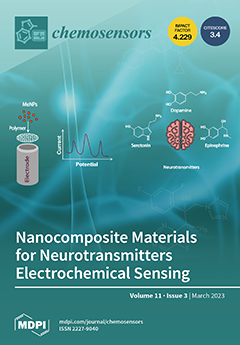In air pollutant monitoring using sensors, moisture can adversely affect the analytical accuracy of volatile organic compounds (VOCs). Therefore, a new moisture pretreatment device (KPASS–Odor) for analyzing VOCs in the air was developed, based on frost and created by a desublimation process inside
[...] Read more.
In air pollutant monitoring using sensors, moisture can adversely affect the analytical accuracy of volatile organic compounds (VOCs). Therefore, a new moisture pretreatment device (KPASS–Odor) for analyzing VOCs in the air was developed, based on frost and created by a desublimation process inside a cold tube. The performance of KPASS–Odor was compared with conventional devices (i.e., a Nafion
TM dryer and a cooler) through the measurements of low water-soluble VOCs (i.e., benzene, toluene, ethyl benzene, p-xylene, and styrene) and relatively high ones (i.e., methyl-ethyl ketone, methyl isobutyl ketone, butyl acetate, and isobutyl alcohol) using gas chromatography (GC) and sensor methods. Regarding the GC method, the recovery rates for KPASS–Odor and the cooler were >95% and >80%, respectively, at a flow rate of 500 mL/min for all compounds. For the Nafion
TM dryer, the recovery rates differed between low and high water-soluble compounds, which exhibited the rates ≥88% and ≤86%, respectively. In terms of the sensor method, the VOC recovery rates of KPASS–Odor and the Nafion
TM dryer were found to be >90% and <50%, respectively. Therefore, KPASS–Odor was determined to be the most suitable moisture pretreatment device for highly soluble VOCs of concern in this study.
Full article





